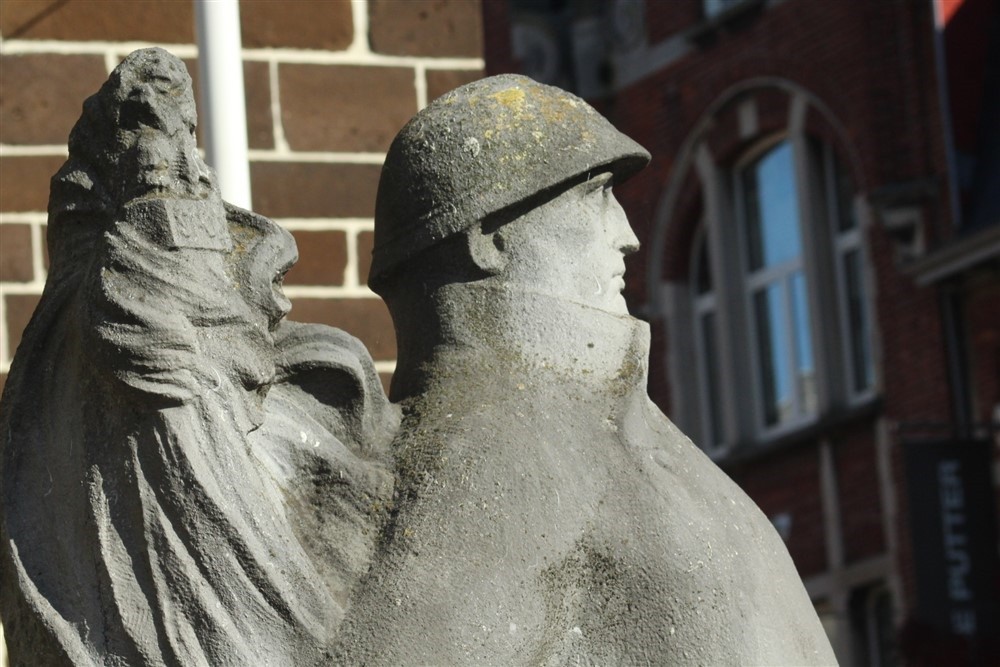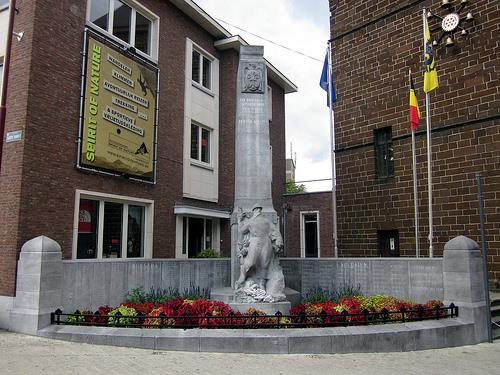War Memorial Aarschot
Aarschot's toll during the first days and weeks of the First World War was extremely heavy. More than 170 civilians were killed coldly by German troops. The majority were hostages who were executed without any trial on the pretext of "Man hat schossen!" More than 380 houses went up in flames.
In 1920, the city council unanimously decided to erect a monument in honor of the fallen soldiers and the murdered civilians. The Brussels architect and artist Victor Creten was asked for the design. The old town hall on the Grote Markt was chosen as the location. This building had been set on fire during the September days of 1914, and its historical value was not considered interesting enough to rebuild it.
An initial design by Creten presented two bronze figures: a soldier and a citizen, reaching out to each other. However, the monument cost 80,000 francs and the Belgian government had no plans to grant subsidies for this. Besides, with one exception, the Belgian State would hardly finance any war memorial after the First World War.
Aarschot decided to erect a less expensive monument and raise funds through registrations, gifts and public parties. A stroke of luck turned out that at the end of 1922 the Fine Arts administration would distribute an annual budget surplus, more than 35,000 francs, equally among the martyr municipalities of Aarschot and Rossignol. The choice for one Flemish and one Walloon municipality was very conscious. The province of Brabant also provided financial support. 25,000 francs were raised by tender.
Creten entrusted the execution of the monument to the famous sculptor and his friend Pieter Braecke. In order to keep costs down, a copy of the soldier of The Defense of the Banner from the war memorial in Ostend was used for the statue in Aarsch. Reportedly, Victor Creten modeled the soldier's face.
In 1923, during the mayor of Felix Daels, the monument was festively inaugurated in the presence of Crown Prince Leopold.
Central to the monument is the almost schematically worked out figure of a soldier, in a pose that is both protective and almost defiantly heroic. Behind him towers the obelisk, symbol of fortitude and virtue, with the glorious coat of arms of Aarschot at the top. At the foot of the soldier is the same shield, broken, symbol of destruction. In the remains of a gun barrel and of a horse we recognize the battlefield. In the right hand he holds the Belgian flag, crowned by a lion and bearing the inscription "S.P.Q.B.", acronym for Senatus Populusque Belgicus and a not so subtle reference of brave Belgium to the greatness of the Roman Empire. At the foot of the soldier is a silver palm with a clear number 9. This refers to the heroic defense of the 9th Line Regiment north of Aarschot to secure the withdrawal of the Belgian troops to the fortress of Antwerp.
On the wall behind the statue, the names of the murdered civilians and the fallen soldiers were immortalized. The names of the victims of the Second World War were usually added on the monuments of the First World War. This happened here on the obelisk, disrupting its original monolithic character. The names of the victims of World War II were revealed on the national holiday in 1946.
Do you have more information about this location? Inform us!
Source
- Text: Jan Rymenams
- Photos: Jan Rymenams (1), Tijl Vereenooghe (2)
Nearby
Museum
- Stedelijk Museum, Room "War and destruction" Aarschot - Aarschot
- Allied Forces Museum Herselt - Herselt
- House of the Franco-Belgian Resistance - Tielt-Winge
Point of interest
- Grote Markt Aarschot - Aarschot
- Glass Window Church Of Our Lady Aarschot - Aarschot
- Peace Carillon Aarschot - Aarschot
Monument
- Memorial Lucien Meyer Aarschot - Aarschot
- Memorial Stone Anna Persy Aarschot - Aarschot
- Jeweler Verhaeghen House Aarschot - Aarschot
Cemetery
- Belgian War Graves Aarschot - Aarschot
- Belgian Graves Veterans Aarschot - Aarschot
- Commonwealth War Graves Langdorp - Langdorp (Aarschot)







